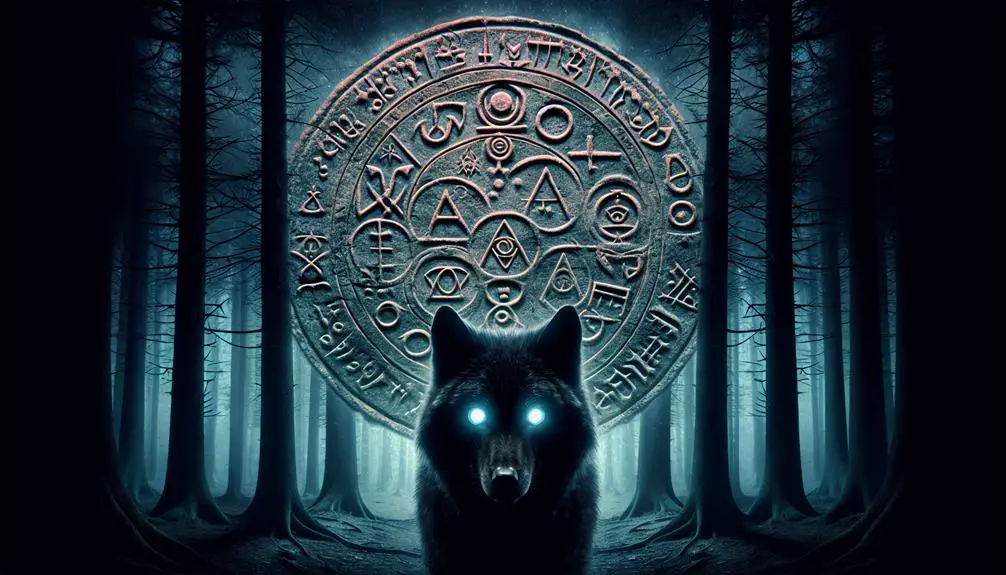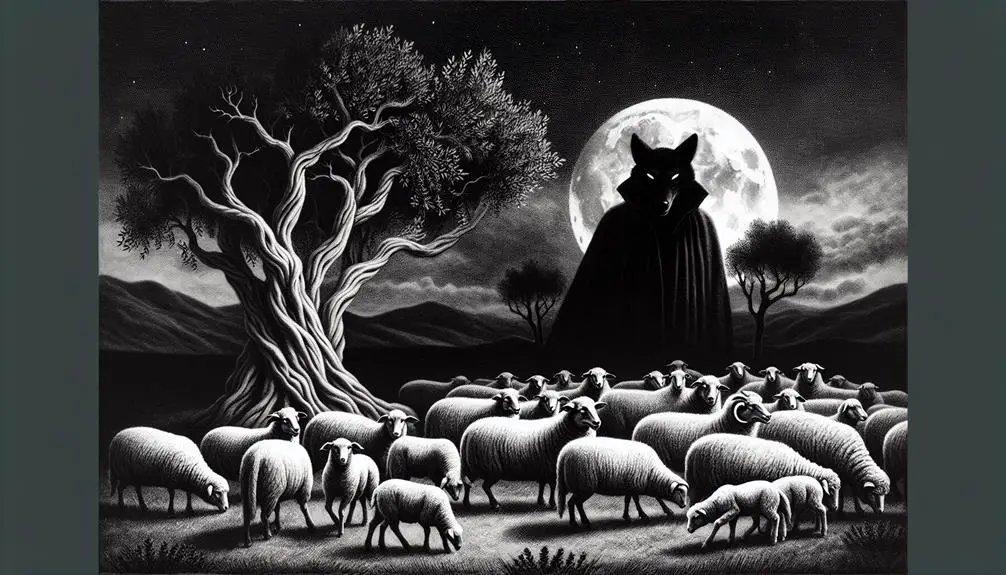Often depicted as symbols of danger and deceit, wolves in the Bible hold deeper meanings that intrigue and enlighten.

Characteristics of Wolves in the Bible
In the Bible, wolves prowl, prey, and portray; they embody danger and deceit, yet also serve as messengers of deeper truths.
You'll find that their symbolism extends beyond mere predatory behavior, hinting at lessons on vigilance and the dual nature of threats both physical and spiritual.
As you explore these ancient texts, consider how the depiction of wolves might mirror the complexities of human nature and societal challenges.
The intrigue lies not just in their portrayal but in what this reveals about the values and fears of those times—and perhaps, what it still reflects about our world today.
Key Takeaways
- Wolves symbolize danger, deceit, and threats to spiritual and communal well-being.
- They represent the need for vigilant leadership and communal unity to counter threats.
- Wolves serve as metaphors for destructive forces and moral decay, warning of the consequences of straying from divine paths.
- The presence of wolves emphasizes the importance of guidance, wisdom, and the collective strength of the community in facing adversities.
Symbolism of Wolves

In the biblical context, wolves symbolize both danger and destruction, serving as a metaphor for entities that threaten the moral and physical well-being of the flock. This imagery underscores the necessity of vigilant leadership and the cultivation of unity within the community to thwart such threats. When you delve deeper, the representation of wolves extends beyond their immediate peril, embodying the challenges that necessitate shepherd guidance and the maintenance of flock unity.
The shepherd's role, as depicted in biblical narratives, isn't merely about leading the flock to pastures but also involves safeguarding them from the metaphorical wolves that lurk, aiming to disrupt and scatter. This necessitates a leader who's both discerning and courageous, capable of recognizing the nuanced threats that wolves represent and taking decisive action to protect the flock. Such leadership ensures that the flock remains cohesive, a unity that's foundational for their collective strength and survival.
Furthermore, the symbolism of wolves highlights the importance of communal vigilance. It's a call to the members of the flock to be aware of the dangers that could infiltrate and erode their unity from within. It emphasizes that while shepherd guidance is crucial, the responsibility for maintaining flock unity doesn't rest solely on the shepherd's shoulders. Each member of the community plays a vital role in preserving their collective well-being, making it incumbent upon them to support their leader and one another.
Thus, in the biblical narrative, wolves serve as a powerful symbol of the threats that necessitate strong, discerning leadership and a united community. These elements are integral to ensuring the flock's survival in the face of adversity, emphasizing the collective effort required to overcome challenges.
Depictions of Danger

Exploring further, it becomes evident that the Bible not only utilizes wolves to symbolize threats but also presents a broader landscape of danger through various depictions that underscore the complexity of moral and spiritual challenges faced by communities. The depiction of wolves, particularly emphasizing their pack behavior and nocturnal activities, serves as a potent metaphor for the unseen dangers that lurk, waiting to prey on the vulnerable.
The following table provides a concise overview of the biblical depictions of danger, highlighting the multifaceted ways in which wolves and their behaviors are woven into this narrative:
Aspect |
Description |
Biblical Reference |
|---|---|---|
Pack Behavior |
Symbolizes organized threats against individuals or groups. |
Matthew 7:15 |
Nocturnal Activities |
Represents unseen, unpredictable dangers. |
Luke 10:3 |
Predatory Nature |
Illustrates the relentless pursuit of evil against goodness. |
Acts 20:29 |
Isolation |
Warns against straying from communal faith and protection. |
John 10:12 |
Spiritual Vigilance |
Encourages constant awareness and defense against sin. |
1 Peter 5:8 |
This analysis reveals the Bible's intricate use of wolves as more than mere symbols of danger; they embody the pervasive and persistent threats to moral and spiritual integrity. By understanding this depiction, you're invited to reflect on the broader implications of these dangers and the importance of community, vigilance, and faith in navigating them.
Metaphors for Deceit

Wolves serve as powerful metaphors for deceit in biblical narratives, highlighting the cunning and treacherous tactics used to lead astray the faithful. This imagery isn't chosen at random; it's steeped in the cultural and environmental context of the times, where wolves were common predators, feared for their stealth and ferocity. The use of wolves to symbolize deceit speaks volumes about the perceived danger of being misled.
In the biblical context, the metaphor extends to include the concept of 'wolves in sheep's clothing,' a vivid illustration that warns of the danger posed by those who appear harmless or even benevolent but harbor malevolent intentions. This imagery underscores the necessity of vigilance and discernment in spiritual matters, as false prophets and teachers can lead believers away from the truth.
- Sheep's Clothing: Symbolizes the disguise used by deceivers to infiltrate and exploit the community of believers.
- False Prophets: Represent individuals who, under the guise of divinely inspired teachers, spread falsehoods and heresies.
- Discernment: The critical skill required to distinguish between genuine messengers of God and those who seek to deceive.
- Vigilance: A constant, watchful attitude recommended to avoid being misled by appearances.
This metaphorical use of wolves not only serves as a warning but also encourages a deeper understanding of the subtleties of deception. It's a call to look beyond the surface, to question and verify, thus safeguarding one's faith and community from the dangers of spiritual deceit.
Messengers of Destruction

In your exploration of wolves in the Bible, you'll find they aren't just metaphors for deceit but also serve as messengers of destruction. Their presence often symbolizes destructive forces at play, woven into biblical narratives to underscore the imminent peril faced by those straying from divine paths.
This imagery, coupled with prophetic warnings, embodies a complex layer of meaning, urging a deeper understanding of their role within the sacred texts.
Symbolic Destructive Forces
Throughout biblical narratives, wolves often serve as symbolic destructive forces, embodying messengers of destruction that underscore the profound consequences of moral and spiritual decay. These creatures aren't merely predators in the physical realm but also represent deeper, more ominous threats to the spiritual well-being of communities. They symbolize:
- The sudden onset of natural disasters
- The threat of enemy invasions
- The erosion of societal morals and ethics
- The spiritual vacuum that invites chaos
In this context, wolves aren't just animals but potent symbols of impending doom. They alert us to the dangers of straying from moral paths, highlighting how such deviations can lead to catastrophic outcomes, including natural calamities and the horrors of war, underscoring the interconnectedness of spiritual health and societal stability.
Biblical Wolf Imagery
Delving into biblical narratives, one cannot overlook the profound role of wolf imagery as messengers of destruction, serving as a vivid reminder of the consequences of moral and spiritual neglect. This imagery not only evokes fear but also serves as an allegorical tool, drawing pastoral parallels between the physical dangers posed by wolves and the spiritual perils of straying from divine guidance. Wolves in these texts symbolize the impending divine judgement awaiting those who deviate from the path of righteousness.
Aspect |
Biblical Context |
Implication |
|---|---|---|
Wolf Imagery |
Symbol of destruction and desolation |
Divine judgement warning |
Pastoral Parallels |
Comparison to shepherds and flocks |
Moral guidance |
Spiritual Neglect |
Consequences of straying from divinity |
Moral and spiritual peril |
Prophetic Warnings Embodied
Wolves, serving as messengers of destruction, embody prophetic warnings that urge you to heed divine mandates or face dire consequences. This symbolic representation encourages a deeper understanding of their role within biblical narratives. Analyzing these creatures' portrayal offers insights into:
- The importance of shepherd guidance to navigate through life's challenges.
- The consequences of straying from moral and spiritual paths.
- The collective strength found in flock unity against external threats.
- The role of divine warnings in fostering communal and individual resilience.
These elements emphasize a complex relationship between divine guidance, community cohesion, and the perils of moral deviation. Wolves, thus, aren't merely predators but symbols that prompt reflection on the balance between adherence to divine will and the dangers of neglecting such guidance.
Lessons on Vigilance

How does the Bible use the imagery of wolves to teach lessons on vigilance? This question invites a deep dive into the metaphorical use of wolves to underscore the importance of being watchful, especially within the context of spiritual and communal well-being. The Bible frequently juxtaposes wolves against the backdrop of shepherd guidance and flock unity, drawing a clear line between the perils of complacency and the virtues of vigilance.
In this light, shepherd guidance emerges as a pivotal theme. The shepherd's role, often emblematic of divine or pastoral leadership, is to protect and guide the flock. This imagery serves as a powerful reminder that vigilance isn't a solitary endeavor but one that requires guidance and wisdom from those positioned to lead. It's an admonition to heed the advice and direction of those who shepherd communities through life's uncertainties.
Simultaneously, the concept of flock unity plays a crucial role. The Bible suggests that wolves prey on the isolated and the straggler, symbolizing the dangers that lurk when unity is forsaken. Thus, it advocates for a collective vigilance, where the flock remains cohesive, supporting one another under the watchful eye of the shepherd. This unity becomes a bulwark against external threats, emphasizing the strength found in communal watchfulness.
Analyzing these biblical narratives reveals a layered message: vigilance is both a personal responsibility and a communal mandate. It's about being alert to the dangers that threaten spiritual and communal integrity, guided by wisdom and united in purpose. This dual emphasis on shepherd guidance and flock unity underscores a holistic approach to vigilance, making it a cornerstone of biblical teaching.
Dual Nature of Wolves

Turning our focus to the dual nature of wolves in biblical narratives, we encounter a symbol that embodies both destruction and guidance, reflecting profound insights into the complexities of moral and spiritual life. Wolves, with their keen predator instincts and intricate pack dynamics, serve as a rich metaphor for understanding the duality of human nature and the divine.
In scripture, wolves are portrayed not solely as agents of danger but also as creatures with qualities worth emulating, such as their strong sense of community and their role in the natural balance. This dual portrayal encourages you to delve deeper into the symbolism of wolves, recognizing their significance in conveying spiritual truths.
Consider these aspects of wolves in biblical context:
- Predator Instincts: Symbolizing the dangers that lurk, seeking to devour the unwary, wolves remind you of the vigilance needed in spiritual and moral life.
- Pack Dynamics: Illustrating the importance of community and cooperation, wolves challenge you to reflect on your relationships and the collective good.
- Guidance: In some narratives, wolves are depicted as guides, leading the way through difficult terrain, symbolizing divine guidance in times of hardship.
- Destruction and Renewal: The destructive nature of wolves, followed by the emergence of new life in their wake, mirrors the cycle of spiritual death and rebirth.
Frequently Asked Questions
How Have Interpretations of Wolves in the Bible Evolved Over Time in Different Christian Denominations?
You've noticed that denotational interpretations of biblical symbols, including wolves, vary widely. This divergence often stems from the historical context of each Christian denomination.
Over time, as societal values and theological understandings have evolved, so have the perceptions of wolves. Initially seen as negative symbols, some denominations now recognize their complexity, reflecting changes in both scholarly analysis and broader societal attitudes towards nature and its creatures.
Are There Any Notable Differences Between the Depiction of Wolves in the Old Testament Compared to the New Testament?
You're diving into whether there's a shift in wolf metaphors from the Old to the New Testament. Testament contrasts reveal nuanced symbolism.
Initially, wolves often symbolize danger and destruction, reflecting societal fears. However, the New Testament leverages these metaphors to emphasize teachings on vigilance and moral integrity.
Analyzing these shifts, you uncover a rich tapestry of evolving meanings, showing how context and time reshape the symbolic portrayal of wolves in biblical narratives.
How Do Wolves in the Bible Compare to Wolf Symbolism in Other Ancient Religions and Cultures?
You'll find that wolf symbolism in ancient religions and cultures varies greatly.
In Roman mythology, the she-wolf who nurtured Romulus and Remus is revered, symbolizing strength and protection.
Conversely, Norse legends often depict wolves with a mix of awe and fear, embodying both destruction and power in figures like Fenrir.
This diversity in symbolism underscores the complexity of wolves as cultural symbols, reflecting each society's values and fears.
What Role Do Wolves Play in Biblical Prophecies, if Any?
Imagine a wolf sneaking through ancient texts, embodying chaos and destruction.
In biblical prophecies, wolf metaphors serve as powerful prophetic symbolism, depicting adversaries and false prophets who prey on the faithful.
These images caution against deceit and moral decay, underscoring the need for vigilance and integrity.
Analyzing these metaphors reveals deep insights into the cultural and religious anxieties of the time, offering a scholarly perspective on biblical narrative and its enduring lessons.
How Have Modern Environmental and Animal Conservation Perspectives Influenced the Understanding of Wolves in the Bible?
You've seen how modern environmental movements and animal conservation efforts, particularly wolf rehabilitation and conservation policies, have reshaped your understanding of these creatures. This fresh perspective challenges traditional views, offering a more nuanced interpretation of wolves.
It's not just about preserving wildlife; it's about reevaluating our historical and cultural narratives. This analytical approach encourages you to see wolves beyond their biblical representation, integrating scientific insights with theological reflections.
Conclusion
In the tapestry of biblical narratives, wolves emerge not merely as creatures of the wild, but as potent symbols woven with threads of warning and wisdom.
You're invited to see them as harbingers of deceit, cloaked in the darkness of danger, yet also bearing lessons on the dual nature of existence.
Like shadows that dance at the edge of light, wolves in the Bible teach you the art of vigilance, urging you to discern the hidden truths that lie beneath the surface.



Sign up